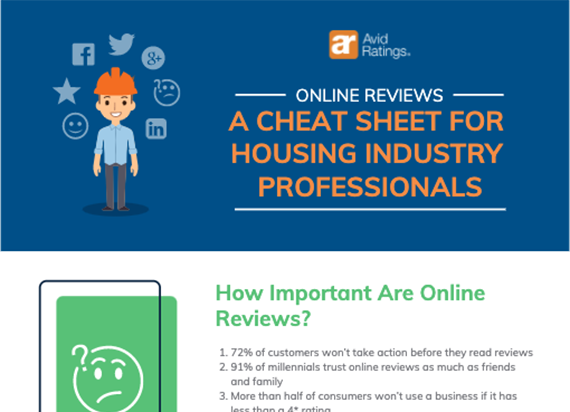Why Online Reviews Matter: A Guide for Housing Industry Professionals
Online ratings and reviews have become universal. But while they might seem like a recent phenomenon, they’re nothing new. In fact, Amazon began letting its customers post product reviews as early as 1995. At the time, many people questioned the retailer’s decision. Fast forward 25 years, however, and we see many consumers “seeking stars” before making an online purchase.
But how powerful are online reviews really — what do recent studies reveal about their influence? As housing industry professionals, how do we generate more positive reviews? And what do we do about negative reviews?
Below we answer these questions and more.
How important are online reviews?
In short — very important.
When was the last time you visited a restaurant, booked a hotel, or purchased a product online without taking a quick glance at customer ratings and reviews? If you never look at reviews, you’re in the minority; recent studies have shown that 72% of customers won’t take action before they read reviews.
The power of online reviews is undeniable and increasing every year. Not convinced? Here are just a few statistics that might change your mind:
- 91% of millennials trust online reviews as much as friends and family
- More than half of consumers won’t use a business if it has less than a 4-star rating
- 83% of customers don’t trust advertising (and may instead pay attention to customers’ recommendations online)
- A single business review can lift conversions by 10% (here, a “conversion” can mean anything from a purchase to a contact form fill)
How do I get more positive reviews?
Positive ratings and reviews are a powerful weapon in the hunt for market share due to their influence over purchase behavior. In fact, improving your review star rating by 1.5 could equal 13,000 more leads.
The question is… how do you get more positive reviews? Here are a few tips:
- Be direct — ask your customers for reviews. Our first tip is straightforward. Just ask and encourage your customers to leave a review of your product or service. You can ask in person, via email, or even on your website. At Avid, we do the work for you by directing your customers to leave additional ratings and reviews across the web. (See more of our AvidCX platform capabilities here.)
- Tell customers how reviews benefit them. When you ask a customer for a review, frame the review as a benefit to them and future customers. By leaving a review, they provide insight that helps you improve your business and the overall customer experience.
- Don’t neglect your Google My Business listing. Roughly 64% of consumers say they’re likely to check online reviews on Google before visiting a business — more than any other review site. To set up Google reviews, you need to claim and set up your Google My Business listing; find details on how to do that here.
- Respond to every review — even negative ones. Harvard Business Review found that replying to customer reviews — both good and bad — resulted in better ratings. Why? By crafting a thoughtful response, you show that you’re human, and it’s easier for other customers to connect and empathize with you. Hence, an uptick in total reviews, especially positive ones.
Speaking of negative reviews…
How do I deal with negative reviews?
Nobody’s perfect. And while the majority of online reviews are positive, you can’t expect a perfect rating or glowing commentary 100% of the time. But — that’s not necessarily a bad thing. The occasional negative review should be viewed as a growth opportunity, providing information and insight to drive improvements.
On top of that, a few negative reviews can actually encourage purchase decisions. Studies have shown that consumers spend five times as long on a site when they interact with negative reviews, with an 85% increase in conversion rate. Why? Because the occasional negative review lends legitimacy. Any business that presents as “too perfect” might seem less credible.
That being said, too many negative reviews can obviously have a detrimental impact on your business. In one survey, 94% of consumers said that a negative online review has convinced them to avoid a business. Similarly, four out of five consumers have changed their minds about a recommended purchase after reading a negative online review.
The key to success lies in turning the occasional online review from a blemish to a beauty mark. In fact, a study by Harvard Business Review found that simply receiving a response — any response at all — increased brand value and a customers’ willingness to interact with the brand in the future. The same study found that customers who have a complaint handled quickly (in less than five minutes) go on to spend more on future purchases.
When it comes to responding to negative reviews, be proactive and empathetic. We recommend including these four elements in your response:
- Greeting (apologize): Use the customer’s name and take responsibility for your business.
- Explanation (show accountability): Explain how the mistake happened and validate the customer’s experience.
- Encouragement (provide resolution): Show you welcome the customer’s engagement and offer appropriate means of atonement.
- Signature (apologize — again): Express regret, offer to make things right, and sign off with your name and title.
Find even more tips to responding to online reviews — both negative and positive — here.
All in all, reviews now impact every brand — from large multinational corporations to small local businesses. As a homebuilding industry professional, it’s important to recognize the importance of online ratings and reviews, be proactive in encouraging positive reviews, and understand the (sometimes surprising) implications of negative reviews and how to handle them. If you have questions about the impact of customer reviews and how to leverage them for your own business, please don’t hesitate to reach out.

Avid Insights Team
Download
(PNG 146k)
